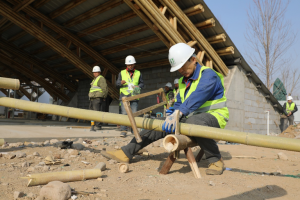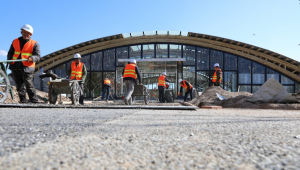
FTA partner the International Bamboo and Rattan Organisation will be taking part in the world’s largest horticultural exhibition, scheduled to open in Beijing this month.
April 2019, Beijing – On April 29, the International Horticultural Exhibition (Expo 2019) will open just outside Beijing, China. The theme of the Exhibition is ‘Live Green, Live Better’, and it is set to be one of the largest expositions ever held: it covers 500 hectares of land, runs for six months, and will be visited by a number of heads of state—including China’s President Xi Jinping — as well as an estimated 16 million guests.
The International Bamboo and Rattan Organisation (INBAR), a partner in the CGIAR Research Program on Forests, Trees and Agroforestry (FTA), will be hosting a large Garden at the Expo 2019. The INBAR Garden aims to promote the use of nature-based solutions for sustainable development and environmental protection.
Bamboo, the fast-growing grass plant, and rattan, the spiky climbing palm, can provide a natural solution for a number of pressing development challenges. Fast-growing, flexible and strong, bamboo and rattan have a range of uses: creating sustainable sources of income in rural areas; restoring degraded lands; storing carbon; protecting biodiversity; and providing a more sustainable, low-carbon solution for products and infrastructure.
There are a number of ways in which bamboo and rattan can contribute to sustainable forest management and agroforestry practices. As a source of energy, bamboo can provide a renewable, legally harvestable replacement for timber, and reduces pressure on scarce forest resources near communities who rely on fuelwood for energy. Bamboo also plays an important component in some farming systems: intercropping with bamboo can reduce water run-off, improve soil health and provide a nutritious source of fodder for livestock. Bamboo and rattan’s role in the protection of some of the world’s most iconic and endangered animals is well known; however, bamboo’s importance for land restoration is only just becoming more recognized, and INBAR Member States have pledged to restore over five million hectares of land using bamboo by 2020.
As well as providing ecosystem services, bamboo and rattan have an important role to play in sustainable socio-economic development. These plants offer a lifeline to millions of people around the world, in some of the poorest rural communities, as a key material used in household products and handicrafts for sale. Strengthening bamboo and rattan value chains has helped to lift hundreds of thousands of people out of poverty around the world.

On top of this, bamboo is enjoying growing importance as a low-carbon replacement for plastic, cement and steel. A recent business article by the Economist summarized the many new low-carbon uses of bamboo, which “is finding its way into a range of new plywoods and plastics”, and creates composites which are “strong enough to build storm-drainage pipes and shock-resistant exteriors for bullet-train carriages.”
The same is true with bamboo housing, which has been used for millennia. In November 2018, bamboo housing shot to international fame with the announcement of a bamboo house design as the winner of the Cities for our Future Challenge, a competition coordinated by the Royal Institute of Chartered Surveyors.
Since its establishment in 1997, INBAR has been promoting the use of bamboo and rattan for sustainable development and environmental protection. In an Ecobusiness editorial published earlier this year, INBAR said that, “As available, scaleable solutions go, bamboo and rattan are a forgotten solution” for environmental protection.
Read also: Standing tall: Bamboo from restoration to economic development
Bamboo and rattan’s benefits for forests and farms will be a key focus of the INBAR Garden at the Expo 2019. The Garden will include:
- A ‘Bamboo Eye’ Pavilion covering 1600 meters squared and made entirely from round-pole bamboo: the largest structure of its kind ever built in the north of China, built by a renowned bamboo architect;
- Exhibitions and events showcasing bamboo and rattan’s role in poverty alleviation, land restoration, climate change mitigation and disaster-resilient construction across INBAR’s 45 Member States;
- A Garden of over 2000 meters squared, containing a range of bamboos and the winning designs of the International Bamboo Construction Competition 2019.
The INBAR Bamboo Eye Pavilion and Garden will be open to any visitors to the Expo 2019 over the next six months, and will be an important way for new audiences to find out more about the potential of bamboo and rattan for forestry and environmental protection.
The INBAR Garden is part of the Expo 2019, and will open on April 29, running for six months until October. For more information, please visit https://www.inbar.int/event/beijing-horticultural-expo-2019/
For more information about how bamboo and rattan can contribute to the Sustainable Development Goals, read https://www.inbar.int/global-programmes/
By Charlotte King, the International Bamboo and Rattan Organisation (INBAR)
The CGIAR Research Program on Forests, Trees and Agroforestry (FTA) is the world’s largest research for development program to enhance the role of forests, trees and agroforestry in sustainable development and food security and to address climate change. CIFOR leads FTA in partnership with Bioversity International, CATIE, CIRAD, ICRAF, INBAR and TBI. FTA’s work is supported by the CGIAR Trust Fund.











